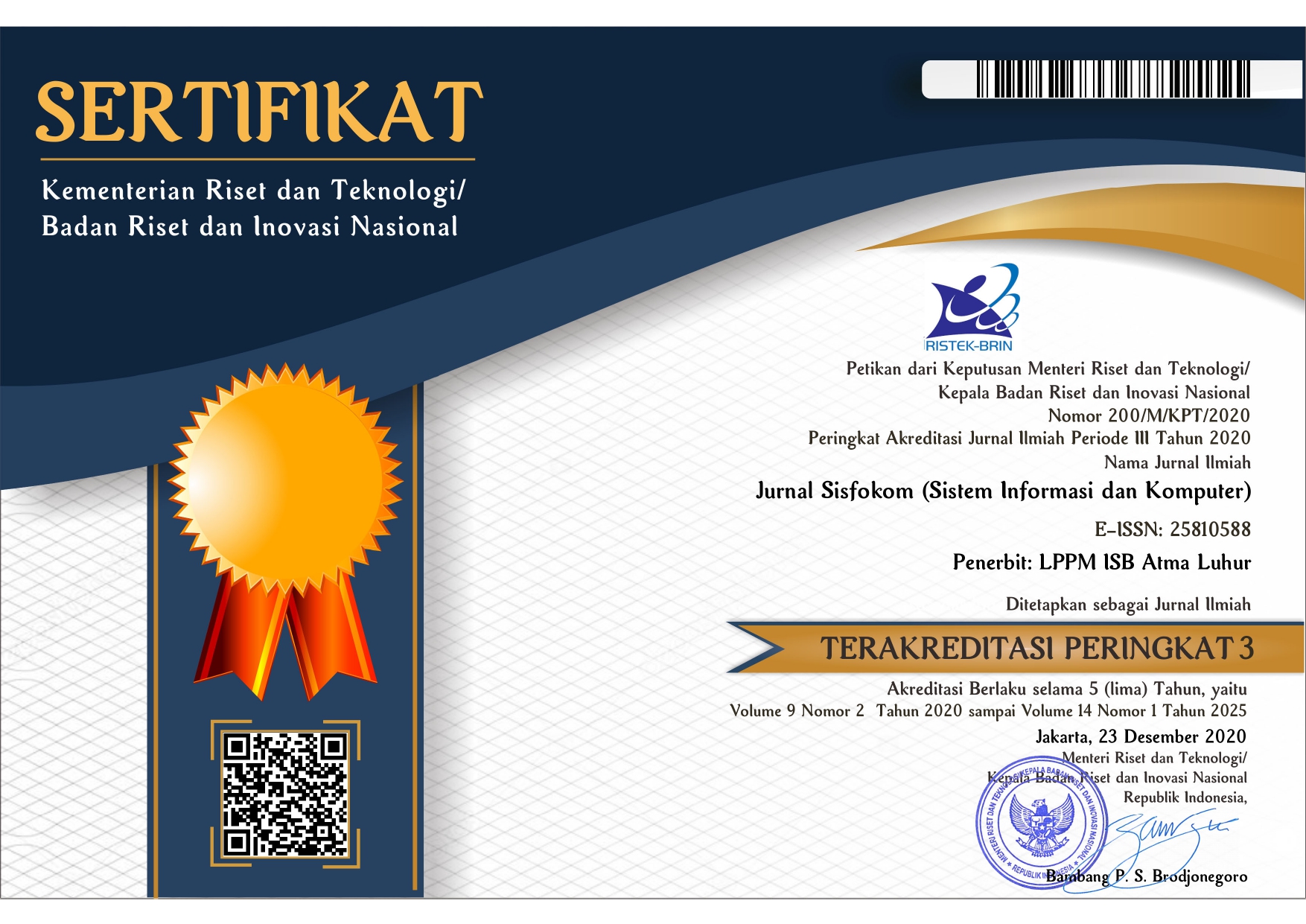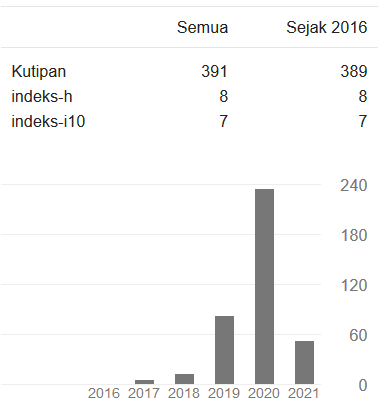Prediction of Grade Point Average (GPA) for Students at Informatics and Computer Engineering Education – Universitas Negeri Jakarta during Online Learning Using Naive Bayes Algorithm
DOI:
https://doi.org/10.32736/sisfokom.v13i1.1958Keywords:
Prediction, Data Mining, Naive Bayes, Online Learning, Grade Point AverageAbstract
The transition of learning models from face-to-face to online learning has had several impacts on student learning, reflected in their academic achievements. This study aims to determine the performance of the algorithm model using data mining classification techniques in predicting the Semester Grade Point Average (GPA) of Informatics and Computer Engineering Education students, at Universitas Negeri Jakarta during online learning. The prediction employed the Naive Bayes algorithm and the dataset obtained by collecting questionnaires from 2020 and 2021 batches. The total data obtained is 155 records with 13 (thirteen) attributes in the form of 1 (one) ID attribute including NIM, 11 (eleven) regular attributes including gender, college entrance, smartphone facilities, network conditions, preferred online applications, interest in learning, learning attitudes, learning creativity, parental support, study groups, and other activities outside of lectures during online learning, and 1 (one) the label attribute namely the Semester Grade Point Average for students in 3rd and 5th semester. The evaluation of this research involved the confusion matrix and the ROC (Receiver Operating Characteristic) curve. Confusion matrix resulted in an accuracy of 75%, precision of 28.33%, and recall of 26.43%. The ROC curve resulted in an AUC value of 0.679, indicating the category of poor classification. This study also applied the SMOTE data balancing technique, leading to a confusion matrix evaluation with 88.46% accuracy, 57.43% precision, and 52.14% recall. Furthermore, the ROC curve resulted in an AUC value of 0.809 which is categorized as a Good classification.References
Y. N. Saputra, “Dampak Perkuliahan Daring terhadap Prestasi Belajar Mahasiswa Teologi Sekolah Tinggi Teologi Cipanas,” Andragogi: Jurnal Diklat Teknis Pendidikan dan Keagamaan, vol. 9, no. 2, hlm. 154–164, Des 2021, doi: 10.36052/andragogi.v9i2.241.
S. DH, Abd. Hafid, Mujahidah, dan Kasma, “Pengaruh Pembelajaran Daring Terhadap Prestasi Belajar Siswa Kelas IV Sekolah Dasar,” Jurnal Pendidikan & Pembelajaran Sekolah Dasar, vol. 1, no. 3, hlm. 359–365, 2022, [Daring]. Tersedia pada: https://ojs.unm.ac.id/jppsd/index
S. Karlina, R. S. Hayati, C. P. Danari, dan N. Nuryati, “Pengaruh Jumlah Jam Belajar Tambahan terhadap Indeks Prestasi Kumulatif Mahasiswa: Studi Kasus di Politeknik Negeri Bandung (Selama Masa Pandemi Covid-19),” dalam Prosiding The 12th Industrial Research Workshop and National Seminar, Bandung, 2021, hlm. 1574–1579.
L. Sitinjak dan A. U. K. Kadu, “Faktor Internal Dan Eksternal Yang Mempengaruhi Kesulitan Belajar Mahasiswa Semester IV AKPER Husada Karya Jaya Tahun Akademik 2015/2016,” Jurnal AKademi Keperawatan Husada Karya Jaya, vol. 2, no. 2, 2016.
N. Laila, “Aspek Psikologi Pembelajaran Daring Masa Pandemi COVID-19 Dengan Capaian Indeks Prestasi Kumulatif Mahasiswa Vokasi,” Jurnal Ilmiah Pamenang - JIP, vol. 2, no. 2, hlm. 7–16, 2020, doi: 10.53599.
M. N. Faruqhy, D. Andreswari, dan J. P. Sari, “PREDIKSI PRESTASI NILAI AKADEMIK MAHASISWA BERDASARKAN JALUR MASUK PERGURUAN TINGGI MENGGUNAKAN METODE MULTIPLE LINEAR REGRESSION (STUDI KASUS: FAKULTAS TEKNIK UNIVERSITAS BENGKULU),” Jurnal Rekursif, vol. 9, no. 2, hlm. 172–183, 2021, [Daring]. Tersedia pada: http://ejournal.unib.ac.id/index.php/rekursif/
T. Arifin dan D. Ariesta, “Prediksi Penyakit Ginjal Kronis Menggunakan Algoritma Naive Bayes Classifier Berbasis Particle Swarm Optimization,” Jurnal Tekno Insentif, vol. 13, no. 1, hlm. 26–30, Apr 2019, doi: 10.36787/jti.v13i1.97.
Syarli dan A. A. Muin, “Metode Naive Bayes Untuk Prediksi Kelulusan (Studi Kasus: Data Mahasiswa Baru Perguruan Tinggi),” Jurnal Ilmiah Ilmu Komputer, vol. 2, no. 1, 2016, [Daring]. Tersedia pada: http://ejournal.fikom-unasman.ac.id
I. Bagus, A. Peling, N. Arnawan, I. Putu, A. Arthawan, dan I. Janardana, “Implementation of Data Mining To Predict Period of Students Study Using Naive Bayes Algorithm,” International Journal of Engineering and Emerging Technology, vol. 2, no. 1, hlm. 53–57, 2017, Diakses: 9 Mei 2022. [Daring]. Tersedia pada: https://ojs.unud.ac.id/index.php/ijeet/article/download/34457/20766
Suyanto, Data Mining Untuk Klasifikasi Dan Klasterisasi Data. Bandung: Informatika, 2019.
R. B. Pereira, A. Plastino, B. Zadrozny, dan L. H. C. Merschmann, “Information Gain Feature Selection for Multi-Label Classification,” Journal of Information and Data Manaagement, vol. 6, no. 1, 2015.
E. P. K. Orpa, E. F. Ripanti, dan Tursina, “Model Prediksi Awal Masa Studi Mahasiswa Menggunakan Algoritma Decision Tree C4.5,” Jurnal Sistem dan Teknologi Informasi, vol. 7, no. 4, 2019.
Mustakim dan G. Oktaviani, “Algoritma K-Nearest Neighbor Classification Sebagai Sistem Prediksi Predikat Prestasi Mahasiswa,” Jurnal Sains, Teknologi dan Industri, vol. 13, no. 2, hlm. 195–202, 2016, [Daring]. Tersedia pada: http://ejournal.uin-suska.ac.id/index.php/sitekin
V. Nykänen, I. Lahti, T. Niiranen, dan K. Korhonen, “Receiver operating characteristics (ROC) as validation tool for prospectivity models - A magmatic Ni-Cu case study from the Central Lapland Greenstone Belt, Northern Finland,” Ore Geol Rev, vol. 71, hlm. 853–860, 2015, doi: 10.1016/j.oregeorev.2014.09.007.
F. S. Nugraha, M. J. Shidiq, dan S. Rahayu, “Analisis Algoritma Klasifikasi Neural Network Untuk Diagnosis Penyakit Kanker Payudara,” Jurnal Pilar Nusa Mandiri, vol. 15, no. 2, hlm. 149–156, Agu 2019, doi: 10.33480/pilar.v15i2.601.
N. P. Y. T. Wijayanti, E. N. Kencana, dan I. W. Sumarjaya, “SMOTE: Potensi Dan Kekurangannya Pada Survei,” E-Jurnal Matematika, vol. 10, no. 4, hlm. 235, Nov 2021, doi: 10.24843/mtk.2021.v10.i04.p348.
A. Desiani, S. Yahdin, dan D. Rodiah, “PREDIKSI TINGKAT INDEKS PRESTASI KUMULATIF AKADEMIK MAHASISWA DENGAN MENGGUNAKAN TEKNIK DATA MINING,” Jurnal Teknologi Informasi dan Ilmu Komputer (JTIIK), vol. 7, no. 6, hlm. 1237–1244, 2020, doi: 10.25126/jtiik.202072493.
Y. B. Samponu dan Kusrini, “Optimasi Algoritma Naive Bayes Menggunakan Metode Cross Validation Untuk Meningkatkan Akurasi Prediksi Tingkat Kelulusan Tepat Waktu,” Jurnal ELTIKOM, vol. 1, no. 2, hlm. 56–63, 2017.
N. Gotlieb dkk., “A Multi-Class Neural Network Machine Learning Algorithm to Diagnose Graft Pathology in Liver Transplant Recipients.” [Daring]. Tersedia pada: https://ssrn.com/abstract=4323740
Downloads
Published
Issue
Section
License
The copyright of the article that accepted for publication shall be assigned to Jurnal Sisfokom (Sistem Informasi dan Komputer) and LPPM ISB Atma Luhur as the publisher of the journal. Copyright includes the right to reproduce and deliver the article in all form and media, including reprints, photographs, microfilms, and any other similar reproductions, as well as translations.
Jurnal Sisfokom (Sistem Informasi dan Komputer), LPPM ISB Atma Luhur, and the Editors make every effort to ensure that no wrong or misleading data, opinions or statements be published in the journal. In any way, the contents of the articles and advertisements published in Jurnal Sisfokom (Sistem Informasi dan Komputer) are the sole and exclusive responsibility of their respective authors.
Jurnal Sisfokom (Sistem Informasi dan Komputer) has full publishing rights to the published articles. Authors are allowed to distribute articles that have been published by sharing the link or DOI of the article. Authors are allowed to use their articles for legal purposes deemed necessary without the written permission of the journal with the initial publication notification from the Jurnal Sisfokom (Sistem Informasi dan Komputer).
The Copyright Transfer Form can be downloaded [Copyright Transfer Form Jurnal Sisfokom (Sistem Informasi dan Komputer).
This agreement is to be signed by at least one of the authors who have obtained the assent of the co-author(s). After submission of this agreement signed by the corresponding author, changes of authorship or in the order of the authors listed will not be accepted. The copyright form should be signed originally, and send it to the Editorial in the form of scanned document to sisfokom@atmaluhur.ac.id.









